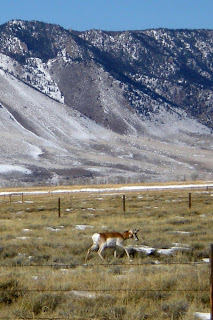This species is sometimes referred to as 'antelope', as in the song Home on the Range, but this is a unique animal not at all related at to the antelopes of Africa. The scientific name (according to desertusa.com) means "American antelope goat," but this animal is not a goat, either.
Pronghorn don't exhibit the graceful jumping skills of antelope, goats or deer. Their legs are developed for running more than jumping, and they will usually crawl under a fence rather than jump over it. They do much better on their long migrations, therefore, when there are wide open spaces with no fences. In the following picture a male pronghorn overlooks his harem in an open space within Laramie's city limits--land that I fear will soon be filled with subdivisions.
Desertusa.com goes on to say: "The Pronghorn is the only animal in the world with branched horns (not antlers) and the only animal in the world to shed its horns, as if they were antlers." Not only that, but both sexes can have these horns, not just the males. About a third of females have horns, though their horns are smaller than their ears and rarely have prongs. Males are distinguishable by both the pronged horns and the dark cheek patches that females lack.
Pronghorn have a unusual reproductive system that results in twins as a matter of course. The young are born in early June or so, and are specially adapted to hide on the ground with no scent or movement until they are able to run from predators. Before their first week is out they can outrun a person. And look how cute!
Pronghorn are fast and can maintain their high speeds for very long distances. They evolved to outrun the cheetah-like predator that used to roam the high plains with them. I once drove along a gravel road as pronghorn ran beside me. I was going about 35 mph. The pronghorn were only jogging casually, and they outpaced the car. To me, nothing captures the wildness of the west like Pronghorn bucks running through the sagebrush in early summer.






No comments:
Post a Comment